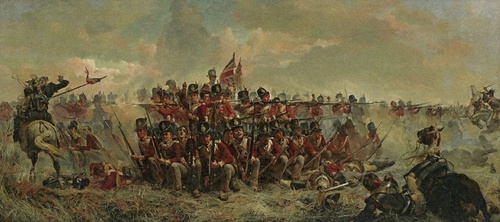Auction: 18002 - Orders, Decorations and Medals
Lot: 28
Waterloo 1815 (William Downes, 28th Regiment Foot), fitted with replacement steel clip and split ring suspension, edge bruising, otherwise very fine
William Downes was born at Bishops Tawton, Devon, and enlisted into the 28th Regiment, from the Royal Army Reserve, on 3 October 1804. He served in the Hundred Days' Campaign in Captain Henry Moriarty's Company of the 1st Battalion, 28th (North Gloucestershire) Regiment of Foot. Part of Sir James Kempt's Brigade in Picton's 5th Division, the 28th were heavily engaged at the Battle of Quatre Bras on 16 June 1815. Forming square, the 28th stood firm against repeated attacks from French cavalry. This action is immortalised in a painting by Lady Butler (1846-1933), which erroneously shows the 28th wearing Belgic shakos instead of their distinctive Stovepipes.
At the Battle of Waterloo two days later, Picton's Division were positioned on the reverse slope just east of the Brussels-Charleroi road, forming the centre-left of Wellington's line. Veterans of the Peninsular War, the 28th were proficient in the 'reverse slope' tactic developed by Wellington to repulse dense formations of French infantry. Following a heavy bombardment by the French 'Grand Battery', at 1.30pm d'Erlon's I Corps - totalling 14,000 infantry - advanced towards Wellington's centre-left in four huge divisional columns, each with a frontage of about 200 files. The leftmost division under Quiot peeled off to attack the Allied-held farmhouse of La Haye Sainte, defended by the King's German Legion. Quiot approached the strongpoint from the south and west, sending another brigade under Bourgeois to attack the eastern side. Squadrons of French Cuirassiers advanced in support, cutting to pieces the unfortunate Luneberg Battalion, sent by the Prince of Orange - in line formation - to re-inforce La Haye Sainte's garrison. The French appeared to be winning: they had surrounded the farmhouse, driving back Bylandt's Dutch brigade. About 100 paces behind Bylandt were the British brigades of Kempt and Pack. Kempt's brigade opened fire on Bourgeois' brigade as it crossed the Chemin d'Ohain, a sunken road running east from La Haye Sainte. This feature disrupted the French formation and temporarily delayed Bourgeois' advance, but the French had learned from previous encounters with British infantry and had spread out into line, ready to return fire. Their volleys tore into the British lines, killing Picton and inflicting murderous casualties. Pack's brigade started to waver in the face of overwhelming numbers, and the Allied centre seemed about to collapse. At this critical moment, Lord Uxbridge committed the Household and Union Brigades of British heavy cavalry. Their charge against d'Erlon's Corps was unexpected and highly successful, driving the French back in disorder and saving Wellington's position. D'Erlon's shattered Corps would not regroup until 4p.m., by which time the Prussian Army already threatened Napoleon's right.
When La Haye Sainte fell to the French at 6p.m., Marshal Ney brought artillery forward to pulverise Wellington's centre. The brigades of Pack and Kempt were devastated, the 28th Foot enduring particularly heavy losses. The regiment sustained 252 casualties by the close of battle, from an original complement of 557.
The 28th made an important contribution to the Allied victory: in delaying the advance of Bourgeois' brigade they took some of the pressure off La Haye Sainte, allowing its garrison to fight on. Kempt and the 28th Foot received special mentions in Wellington's Waterloo Dispatch for their bravery at Quatre Bras and Waterloo.
Discharged to the 3rd Royal Veteran Battalion in April 1820, Downes was finally discharged on disbandment of that unit at Plymouth on 25 July 1821.
Subject to 20% VAT on Buyer’s Premium. For more information please view Terms and Conditions for Buyers.
Sold for
£2,000







